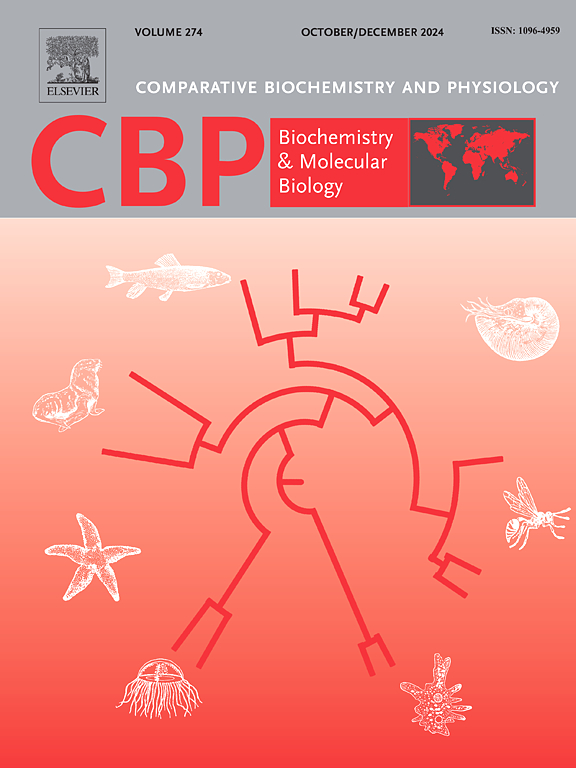大鲵热休克蛋白90家族的全基因组鉴定及对热应激和副溶血性弧菌感染的表达分析
IF 1.9
3区 生物学
Q4 BIOCHEMISTRY & MOLECULAR BIOLOGY
Comparative Biochemistry and Physiology B-Biochemistry & Molecular Biology
Pub Date : 2025-05-19
DOI:10.1016/j.cbpb.2025.111112
引用次数: 0
摘要
热休克蛋白90家族(hsp90)的成员在进化上是保守的,在蛋白质转运、免疫调节和抗原呈递中起着至关重要的作用。本研究从大黄鱼(Larimichthys crocea)基因组中鉴定出5个hsp90,并进行了生物信息学分析。这5种HSP90均编码具有HATPase_c和HSP90结构域的蛋白,主要定位于细胞质、线粒体和内质网。染色体作图显示它们分布在三条不同的染色体上。实时荧光定量PCR (qPCR)分析显示5种hsp90在11个组织中的表达差异。此外,在热应激、副溶血性弧菌感染或两种应激因素共同作用下,分析了它们在肝脏、脾脏、头肾、鳃和血液中的表达动态。结果表明,L. crocea hsp90在不同免疫组织中对上述三种刺激表现出不同的表达模式。值得注意的是,脾脏中的hsp90反应最明显。本研究首次系统阐明了crocea HSP90家族的基因结构特征、组织表达模式和环境胁迫反应机制。这证实了hsp90s在生物(病原体感染)和非生物(热应激)胁迫下表现出显著的功能分化和协同作用,为深入了解水藻环境适应的遗传基础提供了重要线索。本文章由计算机程序翻译,如有差异,请以英文原文为准。
Genome-wide identification of heat shock protein 90 family in Larimichthys crocea and expression analysis in response to thermal stress and Vibrio parahaemolyticus infection
Members of the heat shock protein 90 family (HSP90s) are evolutionarily conserved and play crucial roles in protein transport, immune regulation and antigen presentation. In this study, five hsp90s were identified from the genome of large yellow croaker (Larimichthys crocea) and analyzed using bioinformatics. All five identified hsp90s encode proteins with HATPase_c and HSP90 domains, and are mainly localized in the cytoplasm, mitochondria and endoplasmic reticulum. Chromosomal mapping revealed their distribution across three distinct chromosomes. Quantitative real-time PCR (qPCR) analysis showed differential expression patterns of the five hsp90s in 11 tissues. Additionally, their expression dynamics in the liver, spleen, head kidney, gill and blood were analyzed at 3 h, 12 h, 24 h and 48 h post thermal stress, Vibrio parahaemolyticus infection or under a combination of these two stressors. Results showed that the L. crocea hsp90s exhibited distinct expression patterns in response to the above three stimuli in different immune tissues. Notably, hsp90s in the spleen were most responsive. This study systematically clarified for the first time the gene structure characteristics, tissue expression patterns, and environmental stress response mechanisms of the HSP90 family in L. crocea. It confirmed that hsp90s show significant functional differentiation and synergy in response to biotic (pathogen infection) and abiotic (thermal stress) stresses, and provides important clues for a deeper understanding of the genetic basis of environmental adaptation in L. crocea.
求助全文
通过发布文献求助,成功后即可免费获取论文全文。
去求助
来源期刊
CiteScore
4.60
自引率
4.50%
发文量
77
审稿时长
22 days
期刊介绍:
Comparative Biochemistry & Physiology (CBP) publishes papers in comparative, environmental and evolutionary physiology.
Part B: Biochemical and Molecular Biology (CBPB), focuses on biochemical physiology, primarily bioenergetics/energy metabolism, cell biology, cellular stress responses, enzymology, intermediary metabolism, macromolecular structure and function, gene regulation, evolutionary genetics. Most studies focus on biochemical or molecular analyses that have clear ramifications for physiological processes.

 求助内容:
求助内容: 应助结果提醒方式:
应助结果提醒方式:


